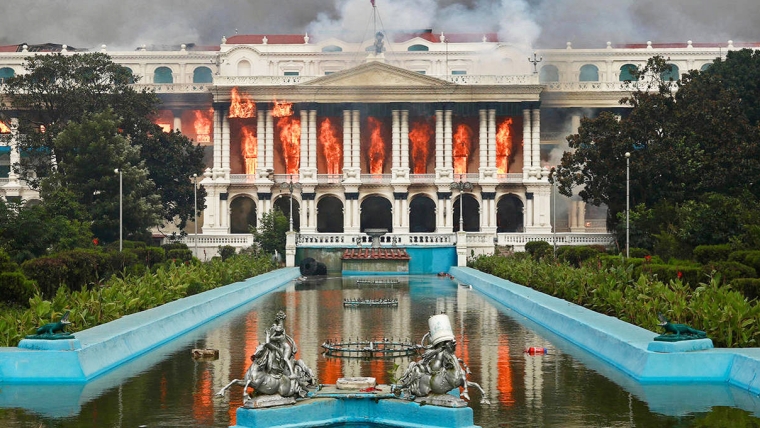
Nirupama Rao*
Although instability is endemic to South and Southeast Asia, it is becoming increasingly dangerous both for India’s neighbors and India itself. This was reflected most recently in the violent unrest in Nepal. But that crisis is hardly an isolated case. In Bangladesh, directly to India’s east, the same tensions that led to the overthrow of the government in 2024 remain unresolved. And to the southeast, Thailand is reeling from the court-ordered removal of its prime minister and a series of recent border clashes with Cambodia.
According to the Armed Conflict Location & Event Data project, Myanmar’s civil war has claimed at least 80,000 lives, both civilians and combatants, since 2021, following the military coup that ended Aung San Suu Kyi’s democratic government. To India’s west, a perpetually volatile Pakistan wrestles with the zombies of its history: Islamist extremist groups and poor economic and governmental performance.
To the south, Sri Lanka may have settled down following the ouster of its president three years ago, but its economy shows few signs of mounting a sustained recovery. And to the north, China’s quest for regional hegemony is another source of instability.
For India, these crises are not distant concerns. Refugee flows from Bangladesh are causing social unease and disruptions in India’s eastern states; the never-ending threat of cross-border terror from Pakistan nearly incited a war in Kashmir this summer; and now, Nepal’s volatile politics have given China another opportunity for meddling. Since this arc of fragility is too large to ignore, the question for India’s leadership is how to absorb and minimize the shockwaves, and how to steady the region.
One can start with Nepal, which has struggled to live by the ambitious constitution that was forged to end a long Maoist rebellion two decades ago. Nepalese state institutions remain fragile and contested, and hopes of stability have been repeatedly dashed by factionalism, corruption, and political leaders’ inability to consolidate a system that everyone can trust. The recent spasm of shockingly brutal violence is a symptom of these deeper fault lines.
India cannot be indifferent to such instability. Our long, open border with Nepal makes us vulnerable to refugee flows and cross-border crime, and our deep cultural, ethnic, religious, and economic ties mean that the government in Kathmandu will always look over its shoulder at the government in New Delhi. Moreover, China’s increasing influence in Nepal’s domestic politics has, as a matter of necessity, made the country a major strategic concern for India.
In Bangladesh, the interim government that has ruled since Sheikh Hasina’s ouster is failing in its efforts to restore law and order or safeguard human rights. The economy, a bright spot for decades, is under pressure from domestic political jitters and US President Donald Trump’s punishing tariffs. The febrile political environment has left the country’s minorities feeling increasingly insecure. The stakes for India are high, because its own efforts to manage the border, migration, and counterterrorism depend on the regime in Dhaka maintaining order.
At first glance, Thailand’s turmoil and the border clashes with Cambodia may seem less urgent. But India, under its Act East policy, has been pursuing deeper economic and strategic ties with the Association of Southeast Asian Nations’ ten member states and their 600 million-plus people. Any instability within that bloc will complicate this outreach. Moreover, Thailand has long served as a bridge between South and Southeast Asia. If its institutions falter, or if disputes with Cambodia escalate despite Malaysian Prime Minister Anwar Ibrahim’s best efforts to broker a resolution, India’s vision of a connected, secure Indo-Pacific corridor could become untenable.
To describe Pakistan as chronically troubled may sound dismissive, but it is an unfortunate truth. The country’s civilian authorities have been consistently undermined, as when Imran Khan’s elected government was ousted in 2022 at the military’s behest. Extremist groups thrive when politics becomes a blood sport, and Pakistan’s fragile economy only exacerbates this dynamic.
From India’s perspective, Pakistan’s troubles are more than a domestic issue, because they regularly threaten to spill across the Line of Control in Kashmir, fueling terrorism, destroying any prospect for regional peace, and even introducing the specter of a nuclear catastrophe. This continuous instability chains India to the sub-continental chessboard, even when it wants to look outward. The Pakistan-China axis further complicates the status quo, which is unlikely to change in the foreseeable future.
All these stories point to a larger worrying trend: democracy in India’s neighborhood is in retreat. Constitutions are being rewritten, and courts politicized. Sensing weakness, too many army generals see themselves as free to intervene, including by jailing or exiling political leaders.
For India – the world’s largest democracy – responding to this trend demands a more assertive regional strategy. Of course, for most of South Asia, barring Pakistan, India is the first responder when crises hit. But during periods when India’s neighbors do not think they need its help, they tend to shrug off its security concerns.
And as if India’s neighborhood were not dangerous enough, the wider world adds its own layers of uncertainty. Trump’s policy toward the region has been arbitrary in the extreme, leading smaller states to hedge their bets. In Japan and South Korea, debates are underway about the wisdom of acquiring nuclear weapons, now that China is flexing its muscles and the US security umbrella has been called into question.
Although India has stood its ground in the face of the storm, the regional and Trump-induced volatility is making it harder to maintain the country’s treasured strategic autonomy. The task now is no longer to deepen ties with America, but to maintain the strategic, technological, and economic core of the partnership while building resistance against sudden shifts in US policy.
India is not seeking dominance in South Asia. Its goal is to build an inclusive, rules-based, and connected region – and thus transform a history of recurring crises into a future of enduring stability.
Nirupama Rao is a former foreign secretary of India and former Indian ambassador to China and the United States. Copyright: Project Syndicate, 2025, published here with permission.
2 Comments
Are these inevitable consequences of enormous human populations with not enough to go around so fight over crumbs?
Nepal looks increasingly like a fuse to a powder keg. The territory itself must be of huge temptation to China and India , for its own security, simply could not countenance any such advancement. India and China have long been sparring and heavily so. Both employ an enormous military force by international standards. Don’t need any matches near that powder keg then.

We welcome your comments below. If you are not already registered, please register to comment
Remember we welcome robust, respectful and insightful debate. We don't welcome abusive or defamatory comments and will de-register those repeatedly making such comments. Our current comment policy is here.